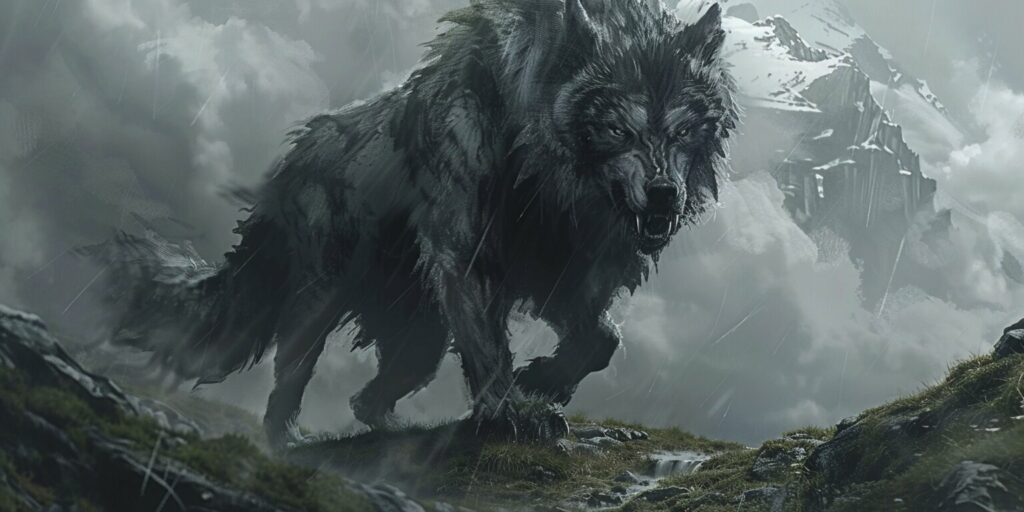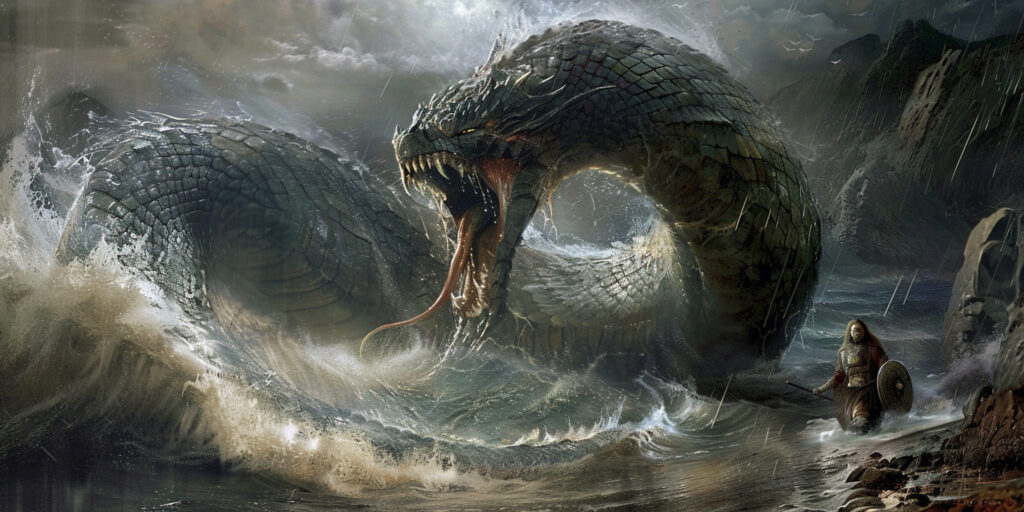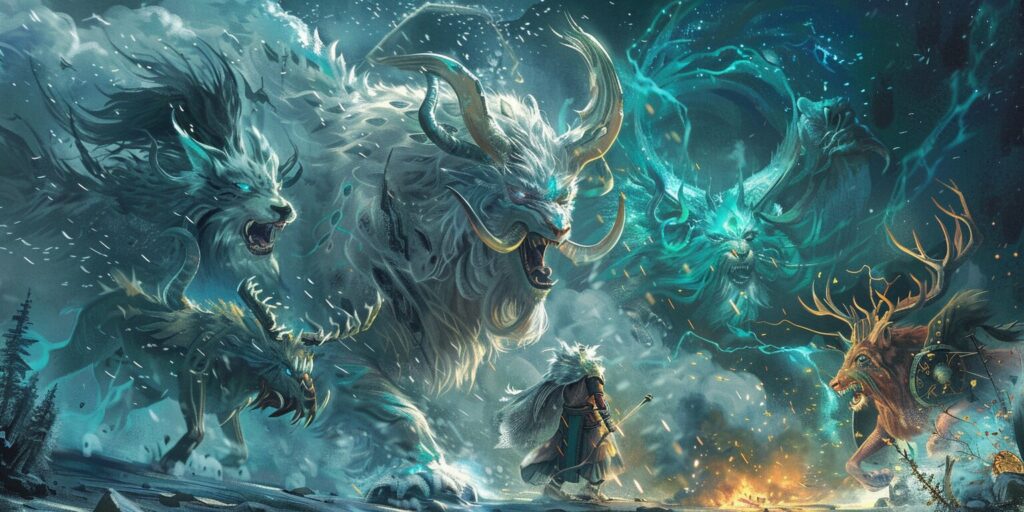Creatures in Norse mythology, Dwarves, Fenrir, Jörmungandr (Midgard Serpent or World Serpent), Norse Mythology, Sleipnir, Tales of the Gods, Valkyries
The Ultimate Guide to Norse Mythology Monsters: Myths and Legends Unveiled
Step into the alluring realm of Norse mythology monsters. Here, ancient tales and legends combine to unveil the intricate world of old Norse. This guide unveils the beasts of Norse myths, sourced from key texts such as the Poetic Edda and Prose Edda.
Exploring these myths offers a peek into the roots and importance of these mythical beings. They all play a crucial part in the grand tales of Norse myths. Get ready for an adventure through both fantastical and historic accounts. Dive into the stories and expert views that animate these ancient creatures.
Exploring Monsters in Norse Mythology
Norse mythology is a treasure trove of interesting characters, including everything from fierce giants to clever gods and goddesses. This world opens a door to Norse beliefs, values, and nature’s wonders, filled with beings and creatures as diverse as light elves and dark elves. We’ll look into the origins and meanings of these Norse creatures.
Introduction to Norse Mythology
Norse mythology comes from Scandinavia and features tales of beings and creatures like Muninn and Hel. It’s full of stories about powerful gods and goddesses who interact with many creatures. These tales often focus on the nine worlds connected by Yggdrasil, a huge cosmic tree.
Overview of Norse Mythology Creatures
Monsters of Norse mythology are unique and wide-ranging. Valkyries pick bold warriors for Valhalla, while Loki’s tricks sometimes change the fate of Asgard and the entire Norse world. These stories are full of battles, alliances, and clever schemes.
Common Norse Mythological Creatures
Some Norse mythology monsters stand out more in the stories:
- Fenrir: A huge wolf that’s part of Ragnarok, the mythic end of the world.
- Sleipnir: Odin’s steed with eight legs for running through all realms.
- Jörmungandr: A serpent so big it encircles the Earth.
- Valkyries: Warrior maidens who guide heroes to Valhalla when they die.
- Dwarfs: Masters of crafting and smithing, they make powerful items.
These creatures make the myths thrilling and reveal what Norse people valued and feared. They vividly picture the Norse universe by telling stories of courage, betrayal, creation, and ruin.
Unraveling Fenrir: The Monstrous Wolf
Fenrir is a monstrous wolf from Norse tales, feared by all. He is the offspring of Loki, the clever god, and Angrboda, a giantess. In Norse myths, Fenrir symbolizes chaos and unpredictability. He plays a crucial role in Ragnarök, the mythic end of the world.

Fenrir in Norse Mythology
Fenrir was born and grew strong, worrying the gods. They tried to trap him but failed until they used Gleipnir, an unbreakable rope. This shows how fearsome and cunning Fenrir is.
The Prophecy of Fenrir
Fenrir’s story is tied to a prophecy about Ragnarök. It says he will kill Odin, the Allfather, during the final battle. This marks the gods’ and monsters’ ultimate showdown, leading to their doom. Fenrir’s tale explores fate and the tragic end myths often tell us about.
Dwarfs: Craftsmen of the Mythical World
Norse mythology is rich with stories about dwarfs and other creatures in Norse mythology. These beings are known for their amazing craftsmanship. Living in Svartalfheim, dwarfs create powerful items for gods and heroes and interact with other beings and creatures like light elves.
The Role of Dwarfs in Norse Mythology
In Norse myths, dwarfs are key figures. They are famed for being the best at making things. Their creations include magical items and weapons used by Norse gods.
Famous Dwarfs in Norse Legends
Brokkr and Eitri stand out among the dwarfs. These brothers make Thor’s hammer, Mjölnir, one of the most famous items. Norse gods often turn to them for their exceptional talent.
Dwarf Blacksmiths and Their Creations
Brokkr and Eitri’s skills shine in Norse fables. Their work gifted the world Mjölnir and Odin’s spear, Gungnir. The feats of these dwarfs are part of Norse mythology’s heart.
- Mjölnir: Thor’s hammer, known for its power and reliability in battle, was crafted with the help of beings and creatures from Svartalfheim.
- Gungnir: Odin’s spear, crafted to always hit its mark.
- Draupnir: A golden ring that replicated itself every nine nights.
The dwarfs’ craftsmanship defines Norse myth’s blend of magic and skill. Their legacy as top artisans is indisputable. The tales of their craftsmanship in Svartalfheim’s forges are remembered for their quality and magic.
Sleipnir: Odin’s Eight-Legged Steed
Sleipnir is Odin’s unique eight-legged horse in Norse myths. Created by Loki, it stands out in the world of myth. Loki’s shapeshifting skills play a big part in Sleipnir’s story.
Origin and Importance of Sleipnir
In Norse tales, Loki turned into a mare and gave birth to Sleipnir after meeting Svaðilfari, a powerful stallion. Sleipnir, Loki’s child, was later given to Odin. The horse was famous for its speed and ability to travel to different realms.
Legends Featuring Sleipnir
Sleipnir is a key character in many Norse legends. One story is about Odin’s journey to the underworld on Sleipnir. In another, they face a major event, Ragnarök, together. These tales show Sleipnir’s strength and the special bond between Odin and his magical horse.
Understanding Valkyries: Choosers of the Slain
The valkyries are key figures in Norse mythology. They guide fallen warriors to the afterlife. Known for their role in deciding who goes to Valhalla, they are both powerful and mysterious. Valhalla is where the bravest find their eternal home.
Valkyries in Norse Beliefs
In Norse tales, the valkyries work for Odin, the main god. Their special power lets them change the course of battles, honoring the most heroic fighters.
They are shown as strong and caring. They balance fate and bravery in Norse stories, where even light elves and dark elves play roles. By choosing who enters Valhalla, they maintain order. This is the place where the honored prepare to fight with gods in a final battle.
Role of Valkyries in Battle
Valkyries appear in the sky during battles. They wear armor and carry weapons. Spotting the bravest in battle, they decide who will join them. But they don’t just watch; they also fight, helping the warriors they have picked.
The valkyries are often praised in Norse poems and tales, alongside mentions of creatures in Norse mythology. Their bravery and wise choices are central themes in these stories about beings and creatures in Norse mythology.
In Norse culture, the Valkyries are seen as symbols of greatness, often depicted with other beings and creatures. Their story, from battles to Valhalla, shows their importance in Norse myths.
The Enigmatic Jörmungandr: The Midgard Serpent
In Norse mythology, the Jörmungandr, or Midgard Serpent, is a giant and fearsome being. It is so huge that it can wrap around the entire world. This makes it a fascinating and powerful character in ancient stories.

Jörmungandr in Norse Mythology
Jörmungandr is derived from Loki and the giantess Angrboða in Norse myths. Its association with such key figures makes the serpent stand out in myths. The serpent is known for its epic tales, especially its fights with Thor.
Mythical Encounters with Jörmungandr
Jörmungandr’s encounters with gods often show its wild and strong nature amidst beings and creatures such as the raven and the giant wolf. One story involves Thor accidentally hooking the Midgard Serpent while fishing. This mistake sparked a battle that shook the earth and changed the fate of Asgard. Such stories highlight Jörmungandr’s power and fear.
Jörmungandr plays a key role in Norse tales, with its key ability and legendary battles. The stories of this serpent are still popular today, and they show the amazing depth of ancient Norse stories.
Ratatoskr: The Mischievous Squirrel of Yggdrasil
Ratatoskr is a well-known squirrel in Norse myths. He lives in the World Tree, Yggdrasil, that joins different worlds. His job is to carry messages and cause trouble. Because of Ratatoskr, Norse stories have more twists and depth, featuring interactions with beings and creatures like the giant wolf and Hel.
Ratatoskr’s Role in Norse Cosmos
In Norse myths, Ratatoskr is a messenger and a source of mischief. He runs from the top to the bottom of Yggdrasil, talks to the eagle and the serpent, and often stirs up trouble in Asgard. His actions show his crafty and playful side.
Legends Involving Ratatoskr
Ratatoskr is famous for his cunning. In one story, he makes the eagle and the serpent fight by twisting their words. This rivalry continues because of the squirrel’s tricks. Such tales show the dangers of false communication, even in grand myths.
Ratatoskr highlights the links between different worlds in Norse beliefs. He makes us aware of the problems that can come from misunderstandings. His tricky yet entertaining behavior makes him a favorite character in Norse lore.
Conclusion
Norse mythology is full of mythical creatures that are central to its stories. From the scary Fenrir to the busy dwarfs, all beings add something special to the tales. These stories have been shared for generations, showing Norse culture and beliefs.
We looked at each creature closely, like the Valkyries who chose the dead or Jörmungandr, the Serpent. Even Ratatoskr, a playful squirrel, is important in these myths. They all build up to Ragnarok, the end of the world, showing how key they are in Norse myths.
The legacy of these myths is seen in our stories, art, and culture today. They give a glimpse into ancient Norse values and fears, including the significance of monsters from Norse mythology. By knowing these tales, we learn about ancient and present human stories. Norse myths are part of our shared human past and culture, keeping their place in our history.

